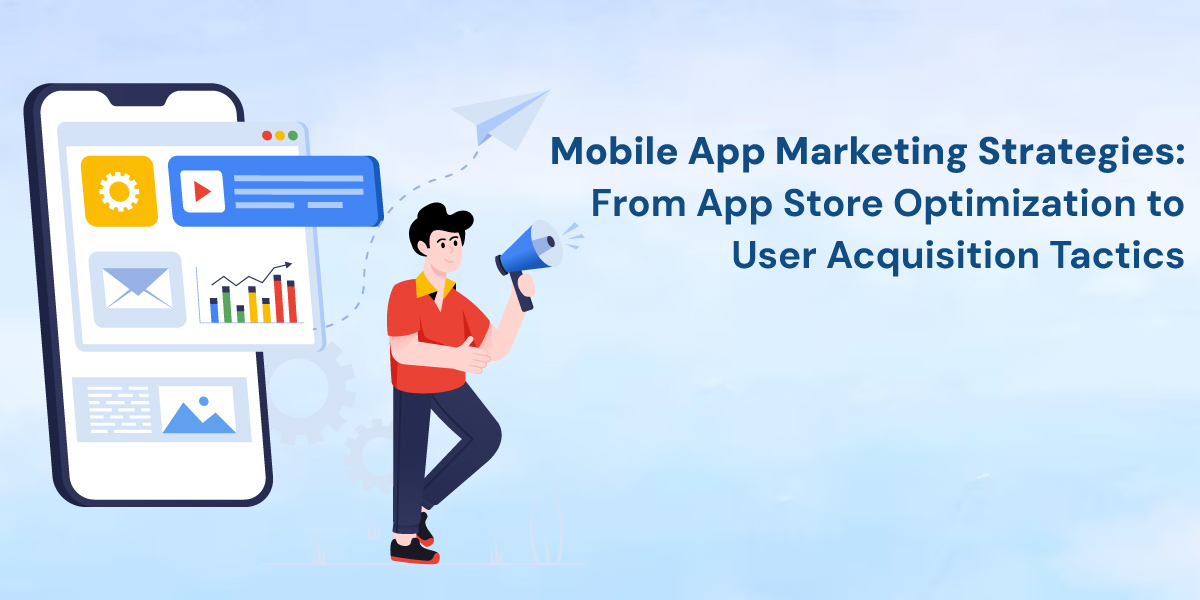Do you know over 80,000 new mobile apps are launched every month via the Google Play store? The App Store contains about 3.4 million applications for download. Mobile applications have grown into indispensable tools for both consumers and businesses in the ever-changing digital environment. With a vast number of applications available, the challenge is not only creating great software but also successfully advertising it. To compete in the ever-changing realm of mobile application marketing, one must have a well-thought-out strategy.
In a competitive sector, your app’s success is determined not just by its capabilities. It is about how you locate your target user population. So, this blog will cover in-depth marketing for mobile app methods. It includes content advertising, social media promotion, ASO, and additional Mobile App Advertising Techniques For Acquiring New Users. This will help you to ensure that your app obtains the recognition it requires and grows a loyal user base.
Understanding the Mobile App Market
Current Trends and Statistics
According to one study, the number of consumers of smartphones has grown by 0.3-0.6 billion annually since the device’s creation. Smartphone subscriptions reached 6.6 billion in 2022, with 7.7 billion expected by 2027.
Here are significant statistics for best mobile app development company and downloads in 2023 and beyond:
In 2022, the Play Store accounted for 110.1 billion downloads, while iOS had 32.6 billion.
The marketplace leader Facebook, with over 2.9 billion active users every month, was the very first social media site to reach a billion active users.
Challenges in Mobile App Marketing
One of the most difficult issues for app developers is getting their software to stand out among a crowded app store. With millions of applications available, it’s difficult to get your app recognized. To address this difficulty, enhance the app’s store listing. This involves employing relevant keywords, designing a visually appealing app icon, writing an interesting app description, and including high-quality pictures and videos.
Getting consumers to download the application is only the first step. The true problem is to convince people to utilize your app regularly. To address this difficulty, you must focus on user retention and acquisition techniques. Paid advertising can help you reach potential consumers and increase app installations.
App Store Optimization (ASO)
What is ASO?
App Store Optimization, also known as ASO, provides a method for increasing an app’s exposure in an app store. App stores rate apps based on a range of criteria. By employing effective keywords and interesting photos, you can rank more highly and drive additional downloads due to increased visibility.
Key Components of ASO
- App Title and Description- The app title or the name is what users see at first. So, the title must be captivating along with a detailed description.
- Keywords- Your description needs to have the keywords or the search terms to make your app visible.
- Visuals (Icons, Screenshots, and Videos)– The visual affects the app downloads. You must include clear screenshots of the UI and Videos explaining your app’s usability.
ASO Tools and Resources
App Tweak, SensorTower, and AppFollow are a few tools and resources that help you optimize your app in the app store.
User Acquisition Tactics
Paid Advertising
It’s fantastic if somebody Googles something, and your content appears on the very first SERP. When individuals search, it usually implies they are prepared to act, which is an excellent chance for you to attract new consumers. There are two basic ways to appear in SERPs: pay-per-click marketing and SEO.
Social Media Marketing
Social media has revolutionized marketing. Almost anyone nowadays has a social networking profile. Establishing a social media footprint allows you to access new audiences and communicate with potential consumers in ways that were previously impossible. However, it’s important to choose the correct platform for your advertising efforts.
Content Marketing
Making content more integrated into the buyer’s experience is the key to effective content-based user acquisition. This will include seeking a solution and locating or acquiring one. This procedure is referred to as the buyer’s journey or customer journey.
Email Marketing
Marketing via email is still an effective way to stay at the forefront with the people you want to reach. Adding additional persons to the email address does not indicate that you have gained new users. However, the purpose of using this strategy is to keep your email subscribers interested and convert them into paying members.
Influencer and Affiliate Marketing
To begin, affiliate marketing along referral advertising are not interchangeable terms. Affiliate marketing, usually referred to as partner marketing, does not offer promotional incentives like discounts or store credit. Instead, it pays commissions on sales, memberships, or other actions made by customers via the affiliate link.
Engagement and Retention Strategies
Onboarding Experience
Onboarding is the first opportunity to create an excellent first impression on prospective consumers. A strong onboarding process knows what your customers want to gain from installing your app and delivers part of that benefit as soon as feasible.
Push Notifications
A good push alert encourages users to log in again when they are most likely engaged with your app. Customize notification times according to opening rates. You must be cautious not to bombard people with excessive alerts. Further, you should also A/B test your messaging.
User Feedback and Updates
You cannot boost your rate of retention without user feedback and updates. Feedback provides you with a baseline from which to operate. It will allow you to identify what is and is not working. If you’re serious about raising your retention rate, you’ll need to base your choices on the finest data possible.
Measuring Success
Analytics and KPIs
Once you’ve specified your app’s goals, select appropriate KPIs to help you measure and analyze its success. KPIs are measurable indications that show how successfully your app meets its goals.
You can track several elements of your app’s achievement, including downloads, consumption, involvement, retention, earnings, reviews, feedback, and loyalty.
To monitor the smartphone app’s KPIs, you must employ analytics programs that can gather, analyze, along report data from the app. There are several analytics solutions accessible via mobile apps, including Google Analytics. These tools will assist you to track and analyze various elements related to your app’s performance.
Adjusting Your Strategies Based on Data
Finally, It is equally important to communicate your findings and take action on them. Share your app’s success data and conclusions with your stakeholders, including your team, management, partners, and customers.
Conclusion
In the continuously changing industry of developing mobile apps, it is vital to implement effective marketing strategies to attract prospective customers. As previously noted, these advertising plans and methods serve as a route map toward success in a competitive industry.
Written By:
Kandarp Patel, the CEO of Cinovic, is a visionary in the field of innovative ecommerce mobile app development. With a robust background in technology and a fervent drive to explore new frontiers, he is dedicated to pioneering digital transformation. At Cinovic, his mission is to breathe life into novel ideas and propel the company toward unparalleled success in the ever-evolving tech landscape

